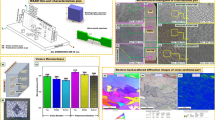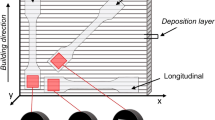Abstract
In this paper, cold-rolled DP590 dual-phase steel sheets with 1.5 mm thickness were butt-welded by a fiber laser, and the evolution and effect on microhardness, tensile property and fatigue property of the welded joint microstructure were studied. The results showed that the base metal is composed of ferrite and martensite, with the martensite dispersed in the ferrite matrix in an island manner. The microstructure of the weld zone was lath-shaped martensite that can be refined further by increasing the welding speed, while the heat-affected zone was composed of ferrite and tempered martensite. The microhardness increased with increasing welding speed, and the hardness reached its highest value—393.8 HV—when the welding speed was 5 m/min. Static tensile fracture of the welded joints always occurred in the base metal, and the elongation at break was more than 16%. The conditional fatigue limits of the base metal and the weld joints were 354.2 and 233.6 MPa, respectively, under tension–tension fatigue tests with a stress rate of 0.1. After observation of the fatigue fracture morphology, it was evident that the fatigue crack of the base metal had sprouted into the surface pits and that its expansion would be accelerated under the action of a secondary crack. The fatigue source of the welded joint was generated in the weld zone and expanded along the martensite, forming a large number of fatigue striations. Transient breaking, which occurred in the heat-affected zone of the joint as a result of the formation of a large number of dimples, reflected the obvious characteristics of ductile fracture.









Similar content being viewed by others
References
Å. Kastensson, Developing Lightweight Concepts in the Automotive Industry: Taking on the Environmental Challenge with the SåNätt project, J. Clean. Prod., 2014, 66(66), p 337–346
G. Avramovic-Cingara, Y. Ososkov, M.K. Jain et al., Effect of Martensite Distribution on Damage Behaviour in DP600 Dual Phase Steels, Mater. Sci. Eng. A, 2009, 516(1–2), p 7–16
H. Huh, S.B. Kim, J.H. Song et al., Dynamic Tensile Characteristics of TRIP-Type and DP-Type Steel Sheets for an Auto-Body, Int. J. Mech. Sci., 2008, 50(5), p 918–931
Y.L. Kang, S. Kuang, X.D. Yin et al., Research on Progress and Development of Dual Phase Steel Sheet for Automobiles, Autom. Technol. Mater., 2006, (5), p 1–5
N. Farabi, D.L. Chen, and Y. Zhou, Microstructure and Mechanical Properties of Laser Welded Dissimilar DP600/DP980 Dual-Phase Steel Joints, J. Alloy. Compd., 2011, 509(3), p 982–989
K. Tsuzaki, Martensitic Transformation and Martensite, Martensitic Transf., 1978, 1, p 1–13
W.D. Callister and D.G. Rethwisch, Materials Science and Engineering, Wiley, New York, 1991
C.R. Brooks and A. Choudhury, Failure Analysis of Engineering Materials, McGraw-Hill, New York, 2002
A. Fazaeli, A. Ekrami, and A.H. Kokabi, Microstructure and Mechanical Properties of Dual Phase Steels, with Different Martensite Morphology, Produced During TLP Bonding of a Low C-Mn Steel, Met. Mater. Int., 2016, 22(5), p 856–862
N. Farabi, D.L. Chen, and Y. Zhou, Tensile Properties and Work Hardening Behavior of Laser-Welded Dual-Phase Steel Joints, J. Mater. Eng. Perform., 2012, 21(2), p 222–230
X. Sauvage, A. Dédé, A.C. Muñoz et al., Precipitate Stability and Recrystallisation in the Weld Nuggets of Friction Stir Welded Al-Mg-Si and Al-Mg-Sc Alloys, Mater. Sci. Eng. A, 2008, 491(1), p 364–371
S.K. Giri and D. Bhattacharjee, Fatigue Behavior of Thin Sheets of DP590 Dual-Phase Steel, J. Mater. Eng. Perform., 2012, 21(6), p 988–994
J. Jia, S.L. Yang, W.Y. Ni et al., Microstructure and Mechanical Properties of Fiber Laser Welded Joints of Ultrahigh-Strength Steel 22MnB5 and Dual-Phase Steels, J. Mater. Res., 2014, 29(21), p 2565–2575
M. Mcholsky, Jr., Fractography: Determining the Sites of Fracture Initiation, Dent. Mater., 1995, 11(2), p 113–116
D. Taylor and J.F. Knott, Fatigue Crack Propagation of Short Cracks; the Effect of Microstructure, Fatigue Fract. Eng. Mater. Struct., 2007, 4(2), p 147–155
D. Hull, Fractography: Observing, Measuring, and Interpreting Fracture Surface Topography, Cambridge University Press, Cambridge, 1999
Acknowledgments
This project is sponsored by the Shanghai Natural Science Foundation of China (Grant No. 14ZR1418800) and the Shanghai Automotive Industry Science and Technology Development Foundation (Grant No. 1404) of China. These supports are gratefully acknowledged.
Author information
Authors and Affiliations
Corresponding author
Rights and permissions
About this article
Cite this article
Xie, C., Yang, S., Liu, H. et al. Microstructure and Fatigue Properties of Laser Welded DP590 Dual-Phase Steel Joints. J. of Materi Eng and Perform 26, 3794–3801 (2017). https://doi.org/10.1007/s11665-017-2848-7
Received:
Revised:
Published:
Issue Date:
DOI: https://doi.org/10.1007/s11665-017-2848-7




